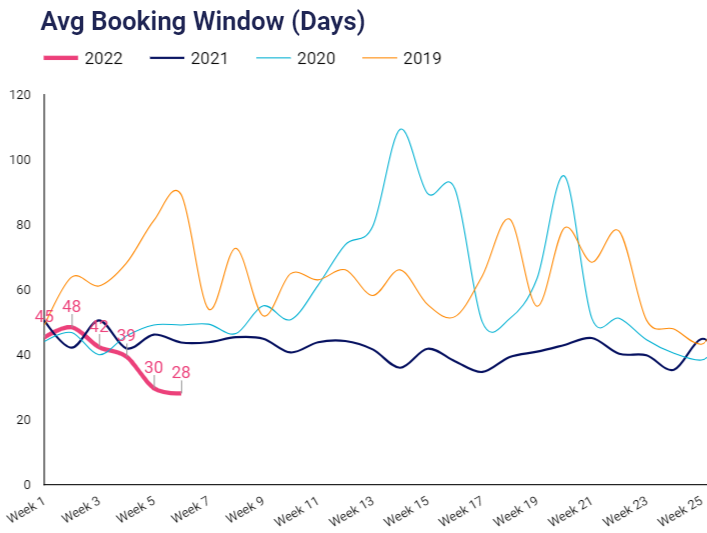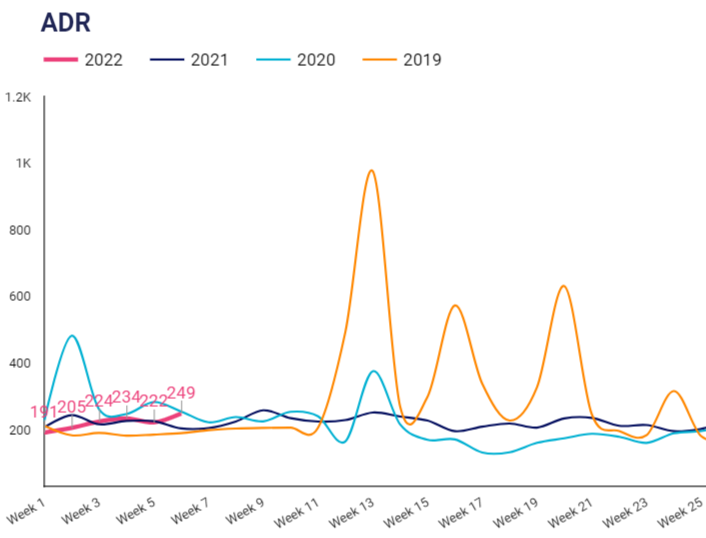Last December, we hosted a webinar where John DeRoulet (Wheelhouse) and I gave our best tips on revenue success going into 2022.
We also made assumptions about what demand was going to look like based on the historical data that was available to us at the time.
But were we right? Seven weeks into 2022, we can start to answer that question. Let’s dig into the data and see what it tells us!

What we predicted in December…
In the webinar, we used the Miami vacation rental market as an example. While each and every market is different, using a concrete example helps to understand revenue management concepts that you can apply to your own business.
Looking at Miami data from 2019, 2020 and 2021, we noticed the following patterns:
- LOS in 2021 was significantly higher than in 2020 and 2019.
- Booking windows were shorter in 2020 and 2021 than in 2019.
- In 2021, there was a shift in seasonality: the summer (which normally isn’t the high season in Miami) was very busy, while the traditional high season didn’t perform as well.
Seeing these trends, we predicted that in this particular Southern US market, 2022 demand would resemble a mix between the historical seasonality of 2019 and the altered seasonality of 2021.
As a result, we suggested that property managers in Miami:
- Consider changing their MLOS restrictions.
- Monitor their booking windows for spring/summer bookings.
- Establish their RevPARs as if this were a historical high season and set reminders for themselves to periodically check whether this strategy is still relevant.
… and what the data proves now
Now that we have some data from 2022, we can see whether our assumptions were correct.
So far this year, LOS has been lower than last year. But it’s following the same curve as in 2021, and it’s significantly higher than 2020 and 2019.

At the same time, booking windows are much shorter than last year—and they seem to be starting a new trend compared to three years ago.

Last but not least, ADRs are tracking marginally higher than in 2021.

So what does this tell us?
Guests are making more bookings, closer to the date, for shorter stays, at the same price or marginally higher than 2021.
This could indicate an increase in willingness to travel. It looks like the Omicron variant has created another wave of pent-up demand.
Fact check against 2022 Industry Trends Forecast.
Not only are guests eager to travel, but they also have money to spend and are choosing vacation rentals as their preferred accommodation option.
This is great news for property managers in Miami, especially considering that the booking volume has increased, too.
So how should you approach revenue management moving forward?
Incorporate potential of Flexible Rental Models.
All in all, we stand by the advice we gave in our webinar—if you missed it, here’s a quick recap.
How to improve your distribution in 2022:
- Optimise your listings for spring break/summer bookings. Rentals United has a variety of tools that you can use to make small adjustments that make a massive difference in your listings’ performance. Check out RU Data Studio Property Health Cards, learn how to improve your listings’ quality score and use extra fees to create an advanced pricing structure.
- Speak with homeowners to ensure availability for in-demand dates.
- Develop a plan to leverage your top-converting channels.
How to approach revenue management in 2022:
- Identify what historical model is going to be the best fit for each month and make adjustments.
- Set reminders for yourself to check back on your strategy and corroborate your assumptions periodically.
- Don’t forget to audit your listings and make sure they have up-to-date hygiene and safety information as well as recent vacation rental reviews.
If you’d like to know the details, watch the webinar recording.
Align projections for Future Property Management.
